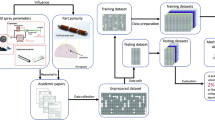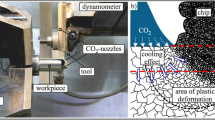Abstract
A stepped shaft, as an integral part of an aeroengine system, is prone to shrinkage cavity defects during open-die composite extrusion, which affects the service performance and life of the fan shaft. First, the deformation process of the fan shaft in open-die composite extrusion was analyzed using finite element simulation. The shrinkage primarily occurred in the forward extrusion stage. Subsequently, the mathematical conditions of the shrinkage cavity in the forward extrusion were obtained using the differential element method. The die parameters affecting the shrinkage cavity were mainly the die inclination and extrusion ratio. A finite element simulation of a simplified forward extrusion model and a machine learning classification algorithm were used to create a shrinkage cavity prediction diagram with solid performance and good generalization. Stepped-shaft forging with satisfactory performance and no shrinkage was obtained by selecting appropriate die parameters according to the shrinkage prediction diagram.

















Similar content being viewed by others
Data availability
The data used in the analysis are obtained by combining the FEM method with the actual working conditions, and the specific data are not published according to the laboratory requirements.
Code availability
The code is fully available and performs well, but is not publicly available.
References
Ku T-W (2020) A combined cold extrusion for a drive shaft: a parametric study on tool geometry. Materials 13(10):2244. https://doi.org/10.3390/ma13102244
Ku T-W (2020) A combined cold extrusion for a drive shaft: experimental assessment on dimensional compatibility. J Mech Sci Technol 34(12):5213–5222. https://doi.org/10.1007/s12206-020-1123-2
Liu Y, Mei Y, Sun C, Li R, Wang X, Wang H, Tan J, Lu Q (2022) A novel cylindrical profile measurement model and errors separation method applied to stepped shafts precision model engineering. Measurement 188:110486. https://doi.org/10.1016/j.measurement.2021.110486
Bakhshi-Jooybari, & M. (2002) A theoretical and experimental study of friction in metal forming by the use of the forward extrusion process. Journal of Materials Processing Technology 125–126:369–374. https://doi.org/10.1016/S0924-0136(02)00343-6
Wang Y, Jia Z, Ji J, Wei B, Heng Y, Liu D (2022) Determining the wear behavior of H13 steel die during the extrusion process of pure nickel. Eng Fail Anal 134:106053. https://doi.org/10.1016/j.engfailanal.2022.106053
Çelik GA, Polat Ş, Atapek ŞH (2017) Effect of single and duplex thin hard film coatings on the wear resistance of 1.2343 tool steel. Trans Indian Inst Met 71(2):411–419. https://doi.org/10.1007/s12666-017-1171-1
Zhao L, Zhou K, Tang D, Wang H, Li D, Peng Y (2022) Experimental and numerical study on friction and wear performance of hot extrusion die materials. Materials 15(5):1798. https://doi.org/10.3390/ma15051798
Li S, Chen L, Tang J, Zhao G, Zhang C (2019) Microstructure and mechanical properties of hot extruded Mg-8.89Li-0.96Zn alloy. Results Phys 13:102148. https://doi.org/10.1016/j.rinp.2019.02.084
Jia L, Li Y, Hui T, Yang Z (2019) Numerical simulation and experimental research on microstructural evolution during compact hot extrusion of heavy caliber thick-wall pipe. Chinese Journal of Mechanical Engineering 32(1). https://doi.org/10.1186/s10033-019-0316-z
Lee J, Jeong H, Park S (2019) Effect of extrusion ratios on microstructural evolution, textural evolution, and grain boundary character distributions of pure copper tubes during hydrostatic extrusion. Mater Charact 158:109941. https://doi.org/10.1016/j.matchar.2019.109941
Meybodi AK, Assempour A, Farahani S (2012) A general methodology for bearing design in non-symmetric T-shaped sections in extrusion process. J Mater Process Technol 212(1):249–261. https://doi.org/10.1016/j.jmatprotec.2011.09.010
Yuan S, Feng LI, Zhubin HE (2008) Effects of guiding angle on plastic metal flow and defects in extrusion of aluminum alloy. Journal of Materials Science & Technology 256–260
Khan MF, Alam A, Siddiqui MA, Alam MS, Rafat Y, Salik N, Al-Saidan I (2021) Real-time defect detection in 3D printing using machine learning. Mater Today: Proceed 42:521–528. https://doi.org/10.1016/j.matpr.2020.10.482
Pratap A, Sardana N (2022) Machine learning-based image processing in materials science and engineering: a review. Mater Today: Proc. https://doi.org/10.1016/j.matpr.2022.01.200
Sah AK, Agilan M, Dineshraj S, Rahul MR, Govind B (2022) Machine learning-enabled prediction of density and defects in additively manufactured Inconel 718 alloy. Mater Today Commun 30:103193. https://doi.org/10.1016/j.mtcomm.2022.103193
Singh P, Rose TD, Vazquez G, Arroyave R, Mudryk Y (2022) Machine-learning enabled thermodynamic model for the design of new rare-earth compounds. Acta Materialia 229:117759. https://doi.org/10.1016/j.actamat.2022.117759
Singh S, Junaid ZB, Vyas V, Kalyanwat TS, Rana SS (2021) Identification of vacancy defects in carbon nanotubes using vibration analysis and machine learning. Carbon Trends 5:100091. https://doi.org/10.1016/j.cartre.2021.100091
Funding
This work was financially supported by Green Manufacturing System Integration Project of the Ministry of Industry and Information Technology (Grant No: 2018272106).
Author information
Authors and Affiliations
Contributions
All authors contributed to the study conception and design. Material preparation, data collection, and analysis were performed by ZhouTian Wang, Songlin Li, and Menglong Du. The first draft of the manuscript was written by Menglong Du and Menghan Wang; all authors commented on previous versions of the manuscript. All authors read and approved the final manuscript.
Corresponding author
Ethics declarations
Consent for publication
All authors agree to publish.
Conflict of interest
The authors declare no competing interests.
Additional information
Publisher's note
Springer Nature remains neutral with regard to jurisdictional claims in published maps and institutional affiliations.
Rights and permissions
Springer Nature or its licensor (e.g. a society or other partner) holds exclusive rights to this article under a publishing agreement with the author(s) or other rightsholder(s); author self-archiving of the accepted manuscript version of this article is solely governed by the terms of such publishing agreement and applicable law.
About this article
Cite this article
Wang, M., Du, M., Li, S. et al. Analysis and prediction of shrinkage cavity defects of a large stepped shaft in open-die composite extrusion based on machine learning. Int J Adv Manuf Technol 127, 2723–2735 (2023). https://doi.org/10.1007/s00170-023-11634-4
Received:
Accepted:
Published:
Issue Date:
DOI: https://doi.org/10.1007/s00170-023-11634-4




